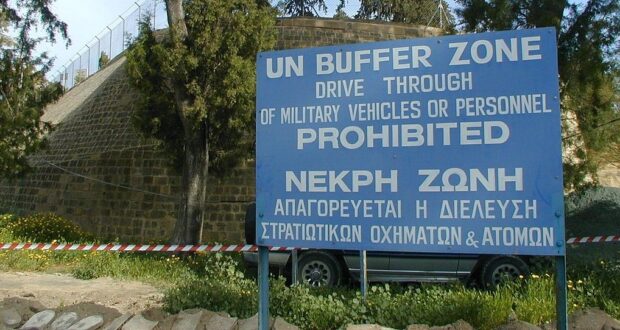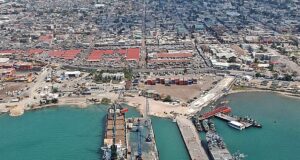13 March, 2021
By Oliver Hegglin – Research Assistant
On 8 February, Cypriot President Nicos Anastasiades and Greek Prime Minister Kyriakos Mitrotakis issued a statement saying that the only solution they see to the Cyprus issue is the re-unification of the ethnically, linguistically and religiously divided island. Two days later, Turkish President Tayyip Erdogan and President of Cyprus’ Turkish North, Ersin Tatar, said that the only solution Turkey and Turkish Cypriots find feasible is a two-state solution. These statements come after United Nations (UN) Secretary General (SG) Antonio Guterres said on 28 January that he intends to bring together all parties to the Cyprus issue (Turkey, Greece, the Republic of Cyprus (Cyprus), the Turkish Republic of Northern Cyprus (TRNC), and the United Kingdom (UK)) in an informal meeting in Geneva, Switzerland, from 27 to 29 April.
These talks would be the first since talks in 2017 failed. Guterres would not be the first UN SG attempting to bring about a lasting resolution to this issue; Multiple SGs have tried, and every so far has failed. Since before Cyprus’ independence, the island has been divided in a sophisticated power-play between Greece and Turkey that included a war. The complex events have polarized Greek- and Turkish-Cypriots, ending in another of the world’s frozen conflicts. With the upcoming meeting in April, it is therefore worth re-examining how Cyprus ended up where it is today and what the proposed and possible solutions to lasting resolution are.
Enosis and Taksim
In very simple terms, the modern history of Cyprus stretches back to when the UK formally annexed the island and turned it into a Crown colony in 1925. However, already before this time, each community was permitted by British colonial rule to set up their own school systems with teachers and material from their mother nations, leading to a slow but gradual identification of Cypriots as either Greek or Turkish. The resulting self-segregation between the majority ethnic-Greek and minority ethnic-Turkish population cumulated nationalistic fervor and developed into Enosis, a Greek word meaning “union” (with Greece) and Taksim, Turkish meaning “partition” (of the island). In 1950, 96% of Greek Cypriots voted for incorporation into the Greek state in an unofficial Enosis referendum.
What followed was a war for independence against the UK that began in 1955 with the goal of Enosis. The guerilla-war was fought on the Cypriot side by the National Organization of Cypriot Fighters (EOKA). A Turkish counterpart known as the Turkish Defense Organization (TMT) also emerged. The war against the UK turned into an inter-communal war until a ceasefire in 1958. The Zurich and London Agreements of 1959 granted the island independence, which it received in 1960. A problematic constitution was signed, but was something Cypriots did not want – rather it was forced on them by negotiators from Greece, Turkey and the UK. Ultimately, the constitution proved “unworkable” and solidified the status-quo rather than encouraging consensus.
The questionable constitution of 1960 set up a Greek-Cypriot presidency and a Turkish-Cypriot Vice-President, both with veto-power. An unbalanced power-sharing system in the legislature, civil service and security forces favoring Turkish-Cypriots was foreseen and voters were divided into separate ethnic rolls, preventing cross-communal candidates from emerging. Crucially, Greece, Turkey and the UK were declared to be “guarantor countries”, and were given the power to unilaterally intervene to maintain the “sovereignty, territorial integrity and independence” of the island. This outlawed Enosis and Taksim. Lastly, the UK was permitted to retain sovereignty over two military bases in Dakeleia and Akrotiri-Episkopi.
The next key year is 1963, when proposed constitutional changes by the then-Cypriot President caused inter-communal violence, forcing British forces to exit their bases and intervene. This established the “Green Line”, which continues to divide the Cypriot capital of Nicosia. The British forces were subsequently relieved in 1964 by what has become one of the longest-standing UN Peacekeeping Missions, the United Nations Peacekeeping Force in Cyprus (UNIFCYP), which monitors the Green Line to this day. Many Turkish Cypriots also withdrew to defended enclaves.
The Cyprus Crisis
In 1974, the military junta in Greece, which supported Enosis, collaborated with Greek Cypriots to overthrow the Cypriot government in a military coup. The coup set a fervently pro Enosis, anti-Turkish and EOKA member as President. Turkey issued a list of demands to rectify the situation, including the removal of this President, withdrawal of Greek officers from the Cypriot National Guard, the admission of Turkish troops to protect their population, equal rights for both ethnic groups, and called on the UK to ensure Cyprus’ neutrality as one of the guarantors. The UK refused, forcing Turkey to take military action.
Operation “Attila-1” called for the Turkish army to land on Cyprus as a show of force in order to compel Greece to negotiate. The Greek Cypriot “Aphrodite Plan” was to prevent Turkey from connecting with Turkish enclaves by attacking these upon word of a Turkish invasion. Then on 20 July, Turkish troops landed on Cyprus’ northern coast, paratroopers dropped near Nicosia and the Aphrodite Plan came into action. On the same day, the UN Security Council adopted Resolution 353, which demanded that all foreign military forces withdraw from the island and for guarantor countries to engage in negotiations. However, in the following days, both Greece and Turkey deployed more troops to the island, prompting the British to organize peace talks on 25 July, which ended in failure on 14 August.
Following this, Turkey presented its first solution to the conflict – the federalization of Cyprus, including a transfer of populations. To force the Cypriot President to make a quick decision, operation Attila 2 was launched and Turkey successfully took control of 40% of the island. An invasion originally justified as a rightful intervention to ensure the status-quo turned into an occupation, leading to the status-quo Cyprus finds itself in today. The Green Line that had divided Nicosia was extended to divide the entire island based on territory controlled by the respective factions. A UN-supervised exchange of populations occurred, involving 165,000 Greeks moving south and about 45,000 Turks heading north. By this time, Cyprus had almost been entirely split into a Turkish north and Greek south. In 1975, the Turkish north established an independent administration and after peace talks resumed in 1980 and failed in 1983, the Turkish Republic of Northern Cyprus was declared, a state which today is only recognized by Turkey.
A Diplomatic Graveyard
The first attempt at peace came in 1978, before the TRNC was declared. Known as the “ABC Plan”, as it was drafted by the USA, the UK and Canada, it called for the creation of a federal state within which each community would administer their respective territories and have a central government on external affairs, defense, currency, telecommunications, and immigration. While both sides rejected this plan, much of it was retained in future proposals.
UNSG Perez de Cuellar in 1986 presented his solution which was similar to the ABC Plan and included veto powers for both President and Vice-President. This was rejected by the Cypriot government while the TRNC accepted the agreement. In 1989, de Cuellar presented a second solution based off his 1986 plan, but the veto power would only be extended to issues of defense, security, foreign affairs, taxation, citizenship, and budgeting. This idea was accepted by Cyprus as a basis for negotiations but rejected by the TRNC.
De Cuellar’s successor, Boutros-Boutros Ghali, presented his own plan in 1992. Political equality was key and territorial adjustments proposed. Talks based on this concept were initiated but abruptly ended by both sides. In 2002, UNSG Kofi Annan presented the Annan Plan, which featured a federation of two constituent parts with a rotating presidency. Cypriots would share a single citizenship in this bi-zonal and bi-communal state. Guarantor states would continue to exist to guarantee the “independence and territorial integrity of Cyprus” while refraining from promoting union with either mother state. After negotiations ended in 2004, the plan was put to a vote in both parts of Cyprus. It was rejected by 76% of Greek Cypriots but accepted by 65% of Turkish Cypriots.
A Federal Union
The 2004 vote was perhaps also influenced by the fact that it occurred just a week before Cyprus officially joined the European Union (EU). Turkish voters likely accepted the plan to reap the benefits such membership entails while Greek voters saw an opportunity to increase political, financial, and overall international dominance over their Turkish counterparts. Turkey too supported this combined resolution and EU membership package, as it too had been a candidate for EU membership since 1999. It is argued that the best chance to break the status-quo was before 2004 as the EU can no longer use membership as leverage; Greeks are at a clear advantage in any negotiations with the TRNC and would need to be convinced of the profits that may come from federalization. The EU elite also allegedly regret permitting Cyprus to enter the EU regardless of a solution in 2004.
What both sides have agreed on since the 1970s, is that a bi-zonal, bi-communal federation would need to be the basis for any reunification. As this was ongoing, support for a political union with Greece has also waned. Greece and Cyprus wish to see the guarantor system ended while Turkish Cypriots see it as necessary to ensure their security through Turkey’s military might. Turkey has proposed that both itself and Greece revert to the initial troop levels provided by the 1960 treaty, (950 Greek and 650 Turkish troops). A possible solution to security concerns is through an expansion of the UNIFCYP mandate into something like the Kosovo Force, the peacekeeping mission in Kosovo tasked with maintaining internal security.
The UK has also offered to give up half its territory on the island and to waive its guarantor status. This may be in connection with the crucial issue of property that was lost when the two populations moved territories and how displaced individuals can be compensated.
The Two-State Solution
A 2009 survey made clear the divide that exists today. While 78% of Greek Cypriots polled in favor of a unitary state, 71% of Turkish Cypriots favor a two-state solution. In October 2020, President Erdogan blatantly declared that the current parameters, which have been used in a negotiation “that has lasted more than half a century”, will not achieve any results. Talks of a federal union would be a “loss of time”, he added, and a two-state solution is what must now be discussed. President Tatar echoed these sentiments by stating that “the world should now respect the fight of Turkish Cypriots to live independently and honorably under its own roof”, referencing an independent state.
Northern Cyprus is weaker in wealth and international significance than Southern Cyprus. This has made the TRNC dependent on Turkey, which has clearly pursued its own interests in recent years, using Cyprus as a bargaining chip in the Mediterranean. While it is natural for a state to pursue its own national interest, Turkey has been analyzed to be attempting to revive the Ottoman empire through domestic and international actions. Turning the Hagia Sophia into a mosque has been assessed to be an effort to “reclaim” its history, while establishing “Safe-Zones” in northern Syria amount to an attempt at expanding Turkey’s territory in the direction of what it once used to be under Ottoman rule. In the recent war between Armenia and Azerbaijan, Turkey vehemently supported Azerbaijan, a state with whom it shares ethnic, religious, linguistic, cultural, historic, and political ties. This amounts to what has been described as “two states, one nation”. And with a two-state solution in Cyprus, it appears as if Ankara sees in the TRNC a “satellite-state”, akin to what Azerbaijan is – a means with which to continue expanding its influence.
De-facto Partition
Many talks to find a lasting solution to the Cyprus issue have taken place since 1974 with shifting positions which settled with the Greek side favoring federalization and the Turkish side partition. In 2010, a pro-independence candidate won the TRNC presidency, and despite 2010 talks of re-unification, the UN cancelled these due to lack of progress. Talks resumed in 2015 but were then ended inconclusively in 2017. In 2020, an anti-reunification candidate narrowly won the TRNC election making it unlikely the TRNC would support reunification anytime soon.
Both Greece and Turkey have proven unwilling to make concessions at the risk of losing influence in the Mediterranean and Cypriot leaders have been reluctant to move forward. The island of Cyprus has become a political proxy representing hundreds of years of Greco-Turkish relations. Given this decades-long political limbo, Turkey has moved to consolidate the TRNC by moving tens of thousands of settlers from Turkey onto the island. It has also been sending oil and gas exploration and drilling ships off the coast of Cyprus in another power-play in the Mediterranean.
Any agreement between Greece and Turkey would need to serve the national interests of both countries. As it stands, Turkey is benefiting from no agreement and has no reason to push for anything other than an internationally recognized TRNC. And as long as the TRNC benefits from its mother-country, it has no reason to seek union with the Republic of Cyprus either. As the years pass and younger generations grow up in a de-facto partitioned Cyprus, it will increasingly become less-likely that Cyprus will be unified in the future. While parties to the Cyprus issue prepare for their meeting with UNSG Guterres this April, they should also prepare for the likely reality that the “frozen conflict”-zone of Cyprus will remain in a state of political limbo, akin to Western Sahara and the Palestinian Territories.
Image: A UN Buffer Zone warning sign on the Greek Cypriot side of the ‘Green Line’ (Source: Jpatokal via CC BY-SA 3.0)
 Human Security Centre Human Rights and International Security Research
Human Security Centre Human Rights and International Security Research




